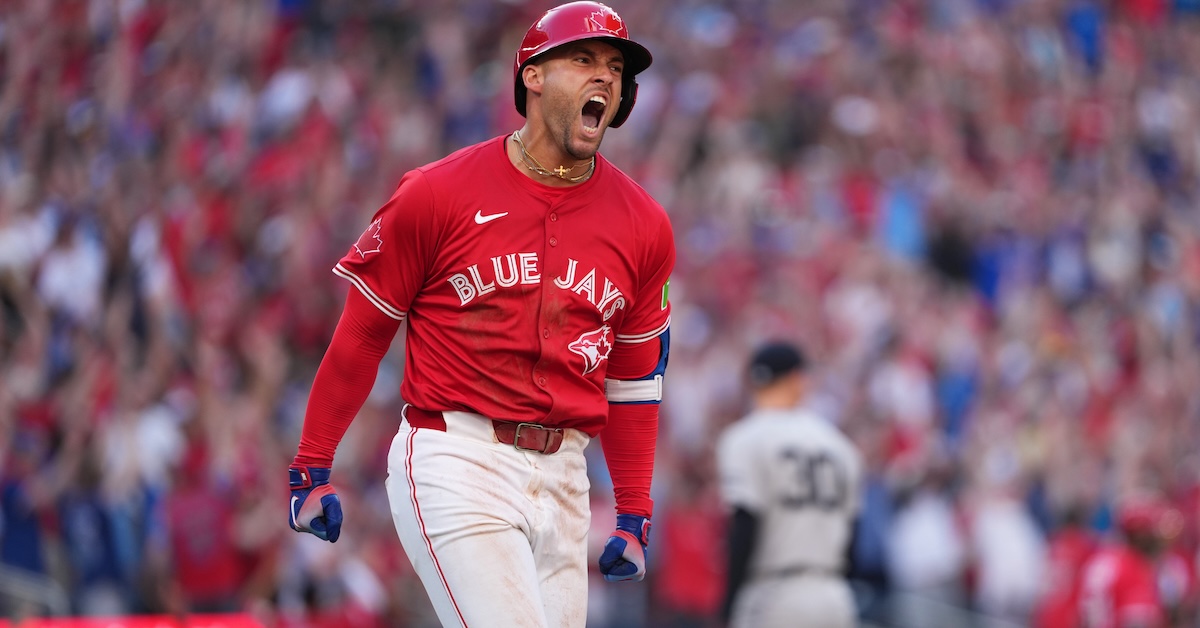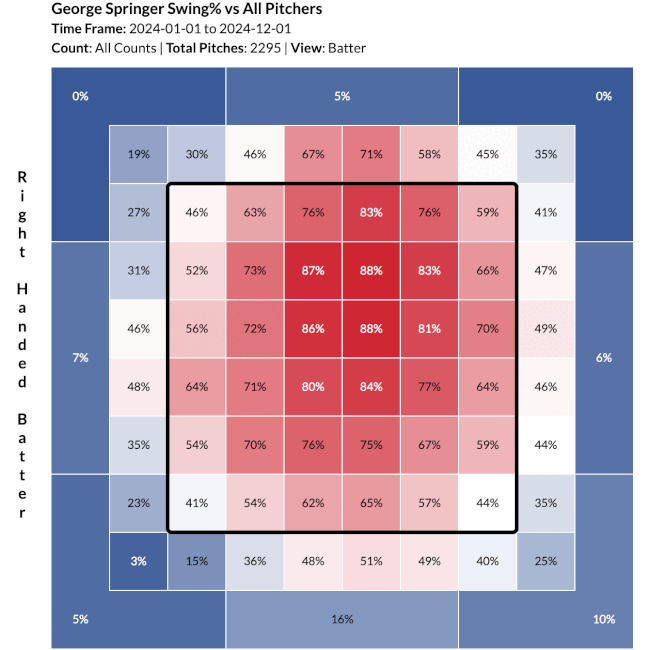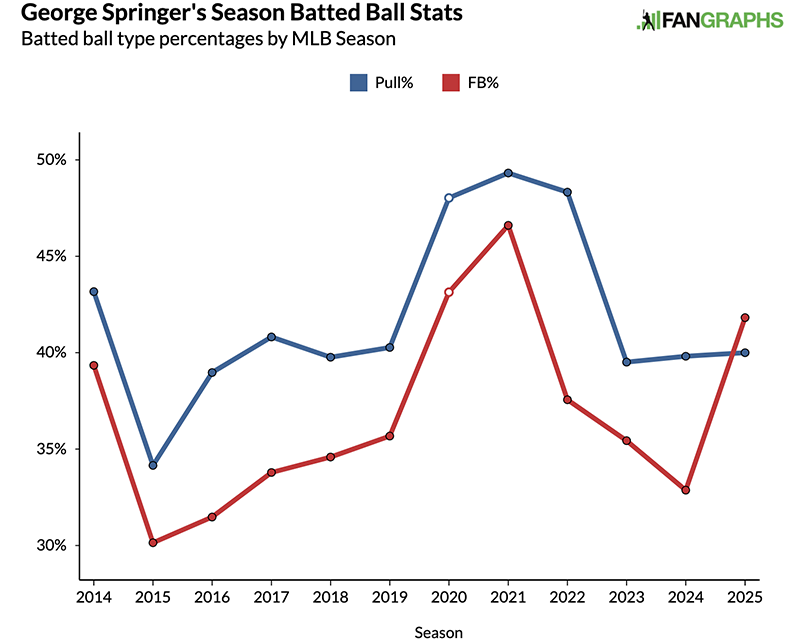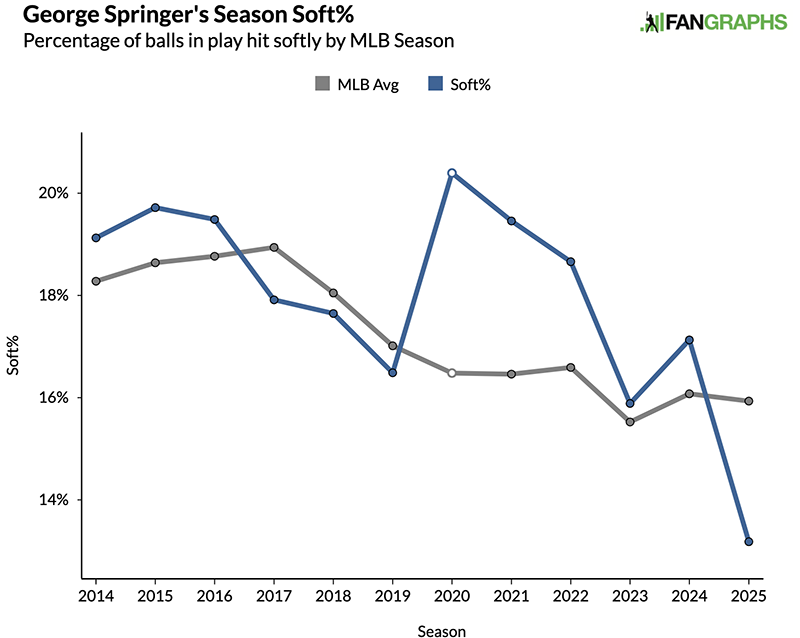Meet the Old George Springer

I owe George Springer an apology. Back in March, I wrote an article with a very simple premise: If Springer got off to a terrible start, the Blue Jays needed to be ready to sit him down. He was godawful at the beginning of spring training, he’d been a below-average player for two seasons in a row, and ZiPS saw him as the seventh-best outfielder on the team. Not the seventh-best defensive outfielder; ZiPS projected that Springer would put up 2.2 WAR per 600 plate appearances, a bounce-back campaign, but still worse than the projections of six other Blue Jays outfielders. I wasn’t saying he was washed or anything, but I was concerned that Springer might deliver more of the same, and that the Blue Jays would keep running him out there even though they had better options available. I needn’t have worried.
“I feel great, actually,” Springer told MLB.com’s Keegan Matheson while he was putting up those abysmal spring training numbers. “For me, it’s about the process. It’s not about the results. I want to make sure that I’m swinging at the right pitches and getting my swing off. Yeah, obviously everyone would like to see the ball hit the grass, but for me specifically, I’m working on the mechanical side of it.” Then the season started, and Springer went out and backed those words up. He’s having a renaissance. A couple months shy of his 36th birthday, he already has 1.8 WAR, and his 143 wRC+ is the best mark he’s put up since he was a fresh-faced 30-year-old Astro in 2020. He’s on pace for his highest home run total since 2019, and he’s running a career-best 12.4% walk rate. So Springer is walking more and hitting for more power, and because of a .303 BABIP, his best since 2016, he’s also running his best batting average in years. How is he doing all this?
Let’s start with plate discipline, because Springer is swinging a lot less often. Springer has always had good plate discipline, but his 19.4% chase rate is the lowest of his entire career. He’s cut his chase rate against fastballs, breaking balls, and offspeed pitches. In case you’re keeping score at home, that’s all of the pitches.

Springer is swinging less often at pitches in the zone too, resulting in more called strikes and more strikeouts. Still, the trade-off has been well worth it.
| Season | BB% | K% |
|---|---|---|
| 2022-2024 | 9.3 | 18.1 |
| 2025 | 12.4 | 19.4 |
| Change | +3.1 | +1.3 |
All those extra walks have Springer running the best on-base percentage of his career. It’s not just that he’s dialed back his aggression either. So far this season, 49% of his swings have come on pitches over the heart of the plate. That’s his highest rate since 2015. Swinging at strikes is great, but swinging specifically at pitches you can really do damage against is even better. Take a look at the heat maps below, comparing his swing rate in 2024 and 2025.

Springer has particularly cut back on pitches up and away and at the bottom of the zone. That doesn’t happen in a vacuum. The lower swing rate on lower pitches is due to the fact that breaking balls tend to come in low, and Springer has cut his swing rate on breaking balls in the zone from 75% last season to 68%. That’s a big deal, because those aren’t typically the pitches that batters are damaging.
Before the 2023 season, I wrote about how Springer had changed his approach multiple times over the years, but always managed to be a great hitter. As he got older and lost some footspeed, he started pulling the ball in the air more in order to make the most of his power. He got away from that over the last two seasons and his numbers cratered, but now that he’s laying off those low breaking balls, take a look at what’s happened to his fly ball rate.

It’s right back up there. This season, 71% of Springer’s hard-hit balls have been hit in the air, the second-highest mark of his entire career. As a result, his wOBACON and xwOBACON – his production and expected production when he makes contact – are the highest they’ve been in years. This is a long way of saying that Springer is doing a better job of swinging at the pitches that allow him to do the most damage. He’s still underperforming those expected numbers a bit because he hasn’t started pulling the ball like he used to – a lot of his fly balls are going to deep center field, where they’re more likely to get caught – but he’s also ripping tons of line drives down the left field line. This is a huge step forward.
Springer’s production on balls in play is up for another reason: He’s hitting the ball harder. His 45.1% hard-hit rate and 90.1 mph average exit velocity are the highest marks of his entire career. What’s really interesting is that Springer’s 90th percentile exit velocity is at 105.7 mph, nowhere near a career high. In fact, it’s not much higher than what it was over the past two seasons. Springer hasn’t unlocked a new level of power; he has goosed all his contact numbers largely by cutting out mishits.

Sports Info Solutions has classified just 13% of his balls in play as soft, and as you can see, that’s by far the lowest number he’s ever put up. Knowing all this – that Springer’s contact quality numbers have gone up largely because he’s cut out mishits and he’s pulling the ball in the air more often – you wouldn’t assume that he’s actually swinging harder, but he’s doing that too. His average bat speed is up from 71.9 mph last season to 73.1 mph this season. Even if you control for pitch type and location, he’s swinging harder, with more loft in his swing, and meeting the ball farther out in front.
As you might expect, swinging harder has allowed Springer to perform better against velocity than he has in years. Over the past two seasons, Springer ran a .332 wOBA against fastballs. This season, he’s at .427. The splits get even more extreme if you look at serious velocity. On pitches 97 mph or higher, those numbers are .232 in 2023 and 2024, and .449 this season. Among players who have seen at least 50 pitches at 97 mph, Springer’s .438 xwOBA puts him in the 94th percentile. He hasn’t just turned things around against fastballs, he’s become one of the best hitters in the league against extreme velocity.
At the same time, Springer’s production against offspeed pitches has fallen off in a major way. He has figured out how to catch up to fastballs, but that’s left him vulnerable to soft stuff. All in all, that’s a pretty good trade-off, especially because he’s not missing offspeed pitches more often; he’s just maker weaker contact against them. Across the league, just under 15% of balls in play come on offspeed pitches, compared to 29% for breaking balls and 55% for fastballs. Generally speaking, it’s better to be a fastball hitter than a changeup hitter.
Springer has been a bit cagey with reporters about what he has changed this season, but it seems safe to assume that he’s gearing up for the fastball more than he did in years past. And he’s not swinging harder by accident. “I don’t want to not have a good swing,” he told the Toronto Star’s Mike Wilner. “I think last year and some times in spring I got myself into trouble not taking the swing that I want to take. But now every game it’s about having my stuff I need to do beforehand, and then getting in the box and getting my A swing off.”
Not all of these changes normally go together. I mean, lots of them do. Springer is doing a better job of swinging at pitches he can hit, so it’s no surprise his bat speed is up. Likewise, he’s swinging at higher pitches, so it’s no wonder he’s hitting the ball in the air more often. But players who suddenly start swinging a lot less don’t always start swinging much harder. It’s hard to maintain an aggressive swing when you’re working with a new, less aggressive approach. And players who start swinging harder and whiffing more often don’t usually see their squared-up rates increase. Players who meet the ball farther out in front usually see their pull rates go up, but that hasn’t happened to Springer yet.
Understanding this, there’s nothing that screams that Springer’s current streak is completely unsustainable. Yes, he’ll cool off at some point, and his BABIP will probably change. But a faster swing, a newfound ability to catch up to velocity, and better plate discipline can’t be anything other than good news. His approach at the plate has changed in many ways over the years, some more subtle than others. What we’re seeing right now is very encouraging. Springer is swinging harder at better pitches to hit, and in some important ways he looks a lot like his old self.
Davy Andrews is a Brooklyn-based musician and a writer at FanGraphs. He can be found on Bluesky @davyandrewsdavy.bsky.social.
I thought Springer was done too, but apparently the Jays MVP this year is the hitting coach Popkins. Gone are Mattingly and the terrible approach he encouraged.
https://www.sportsnet.ca/mlb/article/springers-a-swing-driving-offensive-bounce-back-for-blue-jays/
That’s a bit more detail on the changes Springer made. But it’s awesome seeing Springer destroy everything.